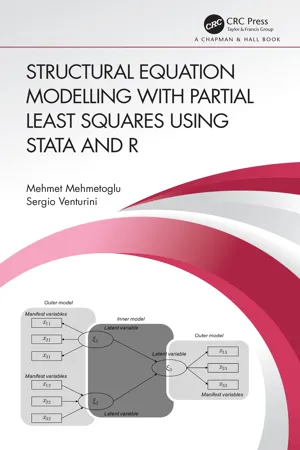
Structural Equation Modelling with Partial Least Squares Using Stata and R
- 400 pages
- English
- ePUB (mobile friendly)
- Available on iOS & Android
Structural Equation Modelling with Partial Least Squares Using Stata and R
About This Book
Partial least squares structural equation modelling (PLS-SEM) is becoming a popular statistical framework in many fields and disciplines of the social sciences. The main reason for this popularity is that PLS-SEM can be used to estimate models including latent variables, observed variables, or a combination of these. The popularity of PLS-SEM is predicted to increase even more as a result of the development of new and more robust estimation approaches, such as consistent PLS-SEM. The traditional and modern estimation methods for PLS-SEM are now readily facilitated by both open-source and commercial software packages.
This book presents PLS-SEM as a useful practical statistical toolbox that can be used for estimating many different types of research models. In so doing, the authors provide the necessary technical prerequisites and theoretical treatment of various aspects of PLS-SEM prior to practical applications. What makes the book unique is the fact that it thoroughly explains and extensively uses comprehensive Stata (plssem) and R (cSEM and plspm) packages for carrying out PLS-SEM analysis. The book aims to help the reader understand the mechanics behind PLS-SEM as well as performing it for publication purposes.
Features:
-
- Intuitive and technical explanations of PLS-SEM methods
-
- Complete explanations of Stata and R packages
-
- Lots of example applications of the methodology
-
- Detailed interpretation of software output
-
- Reporting of a PLS-SEM study
-
- Github repository for supplementary book material
The book is primarily aimed at researchers and graduate students from statistics, social science, psychology, and other disciplines. Technical details have been moved from the main body of the text into appendices, but it would be useful if the reader has a solid background in linear regression analysis.
Frequently asked questions
Information
Part I
Preliminaries and Basic Methods
1
Framing Structural Equation Modelling
1.1 What Is Structural Equation Modelling?
| Univariate | Multivariate |
|---|---|
| Multiple regression | Multivariate regression |
| Logistic regression | Seemingly unrelated regression |
| Multinomial logistic regression | Path analysis (also called simultaneous equation models) |
| Discriminant (function) analysis | |
| Survival analysis | Structural equation modelling |
| Poisson regression | |
| Log-linear analysis | |
| Independent t-test | |
| Analysis of variance | |
| Multilevel regression |
Table of contents
- Cover
- Half Title
- Title Page
- Copyright Page
- Dedication
- Contents
- Preface
- Authors
- List of Figures
- List of Tables
- List of Algorithms
- Abbreviations
- Greek Alphabet
- I. Preliminaries and Basic Methods
- II. Advanced Methods
- III. Conclusions
- IV. Appendices
- Bibliography
- Index